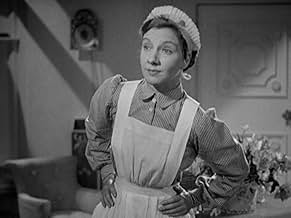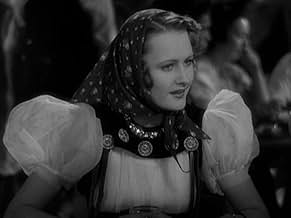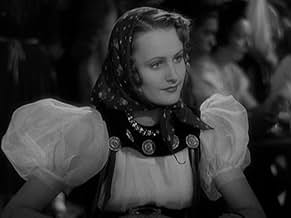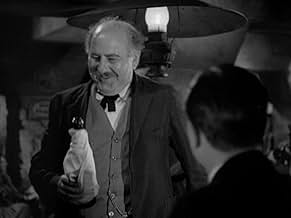AVALIAÇÃO DA IMDb
6,3/10
1,3 mil
SUA AVALIAÇÃO
Adicionar um enredo no seu idiomaA lounge singer is sent by a count to pose as a wealthy socialite.A lounge singer is sent by a count to pose as a wealthy socialite.A lounge singer is sent by a count to pose as a wealthy socialite.
- Direção
- Roteiristas
- Artistas
Mary Philips
- Maria
- (as Mary Phillips)
Rafael Alcayde
- Hotel Clerk
- (não creditado)
Nino Bellini
- Cosmos Club Waiter
- (não creditado)
Agostino Borgato
- Cordellera Bar Waiter
- (não creditado)
Adriana Caselotti
- First Peasant Girl
- (não creditado)
Robert Cauterio
- Hotel Clerk
- (não creditado)
Irene Coleman
- Cosmos Club Hat Check Girl
- (não creditado)
Gino Corrado
- Cosmos Club Croupier
- (não creditado)
Avaliações em destaque
Well, you can't blame Joan for trying. Always wanting to go beyond that glamorous clothes-horse/shopgirl-makes-good mold in which MGM so successfully cast her throughout the 1930's, she was always attempting to outreach her grasp. When Metro's Austrian star Luise Rainer backed out of making a film of Molnar's THE GIRL FROM TRIESTE, a dark photoplay about a prostitute sent on a masquerade in the Tyrolean Alps, Crawford grabbed it, hoping to get her teeth into a meaty role. Imagine her chagrin when Metro executives "improved" the piece to be more suitable for Crawford's image, taking the meat and guts with it. What emerged was an uncomfortable picture built on compromises in an attempt to graft a typical Crawford/Cinderella plot onto what is basically a nasty, mean little story. Registering far below the Crawford usual at the paybox, THE BRIDE WORE RED started her career to skid.
A closer look, however, reveals that not all of the edge has been softened from the piece. I wholeheartedly agree with the reviewer who calls this Joan's most underrated performance, and there is a reason we do not sympathize with this Cinderella. Crawford's Anni is cold and snappish, and has the potential to do real harm to some nice, decent folk. The film plays like the dark side of all of those rags-to-Adrian gown stories Crawford played in the Metro phase of her career, and CRAWFORD IS FULLY AWARE OF THIS. Although seemingly played straight, there is an irony underneath that tells us Crawford herself isn't crazy about Anni either. It's understandable that 1937 audiences did not warm to a Joan they couldn't root for (even her hair is cut into a severe, but stunning, pageboy), but it deserves real recognition now that we are removed from the era and have seen ALL the phases of Crawford's career. In many ways, it's a harbinger of the darker, icier roles she was to play at Warner Bros. and throughout the 1950's.
The performances are uniformly good, with George Zucco strong as the decadent, evil Machiavelli who sends Anni on her masquerade, but Crawford, for the most part, is the standout. Only in the early scenes of the film, when she attempts to portray Anni as a world-weary honky tonk singer (in what must have been the cleanest, most glamorous "dive" in all of Trieste!!) does she fail to convince.
(Ironically, Crawford's next film, MANNEQUIN, released early in 1938 and co-starring Spencer Tracy, was a strictly paint by the numbers Rags-to-Adrian tale, inferior to this, that found great favor with the movie-going public.)
A closer look, however, reveals that not all of the edge has been softened from the piece. I wholeheartedly agree with the reviewer who calls this Joan's most underrated performance, and there is a reason we do not sympathize with this Cinderella. Crawford's Anni is cold and snappish, and has the potential to do real harm to some nice, decent folk. The film plays like the dark side of all of those rags-to-Adrian gown stories Crawford played in the Metro phase of her career, and CRAWFORD IS FULLY AWARE OF THIS. Although seemingly played straight, there is an irony underneath that tells us Crawford herself isn't crazy about Anni either. It's understandable that 1937 audiences did not warm to a Joan they couldn't root for (even her hair is cut into a severe, but stunning, pageboy), but it deserves real recognition now that we are removed from the era and have seen ALL the phases of Crawford's career. In many ways, it's a harbinger of the darker, icier roles she was to play at Warner Bros. and throughout the 1950's.
The performances are uniformly good, with George Zucco strong as the decadent, evil Machiavelli who sends Anni on her masquerade, but Crawford, for the most part, is the standout. Only in the early scenes of the film, when she attempts to portray Anni as a world-weary honky tonk singer (in what must have been the cleanest, most glamorous "dive" in all of Trieste!!) does she fail to convince.
(Ironically, Crawford's next film, MANNEQUIN, released early in 1938 and co-starring Spencer Tracy, was a strictly paint by the numbers Rags-to-Adrian tale, inferior to this, that found great favor with the movie-going public.)
The Bride Wore Red is a ridiculous but fun film. A drunken count, slumming it for the night, runs into a cynical and hungry young woman, Anni Pavlovitch (Joan Crawford). He decides to send her on a luxury vacation to prove his drunken point that the poor and the rich aren't so different after all and buys her new clothes and arranges for her to stay in a luxury resort. Anni, who obviously thinks the whole thing is crazy, decides to go threw with it anyway. Arriving in the alps she meets Giulio (Crawford's real life husband, Franchot Tone) a very pert mail employee who immediately takes a shine to her. The two have sparks aplenty, but when she arrives at the hotel Anni quickly realizes that she would rather always have food on her table than the love of a good man, and quickly sets about seducing Rudi, a flighty engaged man who is very taken with her.
As with most romcoms the real test is if the chemistry works and here it does perfectly. Crawford and Tone have excellent chemistry here and he is very sweet and naive, persistently wearing down the jaded and bitter singer.
It's a lovely sweet film.
As with most romcoms the real test is if the chemistry works and here it does perfectly. Crawford and Tone have excellent chemistry here and he is very sweet and naive, persistently wearing down the jaded and bitter singer.
It's a lovely sweet film.
Dorothy Arzner is the director of this film, and though she does not make a lot of films, she usually makes rather substantial ones. This is certainly a substantial one.
The most appealing aspect of this production is the chemistry and loveliness of the couple played on screen by Joan Crawford and Franchot Tone (married in real life). This is not the only film that MGM has costarred them in together, but in this picture, it is easy to see the magic they create.
For his part, Robert Young is a worthy costar. And so is Joan's dazzling dress, referenced in the title. One must not forget to mention the always splendid Billie Burke, directed in several other pictures by Arzner. This time she portrays a real shrew, not her trademark scatterbrained character.
The most appealing aspect of this production is the chemistry and loveliness of the couple played on screen by Joan Crawford and Franchot Tone (married in real life). This is not the only film that MGM has costarred them in together, but in this picture, it is easy to see the magic they create.
For his part, Robert Young is a worthy costar. And so is Joan's dazzling dress, referenced in the title. One must not forget to mention the always splendid Billie Burke, directed in several other pictures by Arzner. This time she portrays a real shrew, not her trademark scatterbrained character.
Joan Crawford stars in "The Bride Wore Red," a 1937 MGM film based on the play by Ferenc Molnar. Here, it's directed by Dorothy Arzner. Arzner was a fascinating woman - a female director amid a sea of men - very much ahead of her time in her dress, profession, and lifestyle, and highly intelligent. Was she a great director? Hard for me to say. I don't think she always got the best scripts. And in Crawford, she had a headstrong star as well.
The story concerns a poor girl, Anni (Crawford) who sings in a sleazy café (read: with prostitution as a sideline)in the red light district of Trieste. A count she meets believes that the only thing separating the rich from the poor is money - it's not class, it's not breeding, it's not education. To make his point, he sends Anni to a fabulous resort with beautiful new clothes for two weeks. Anni meets Rudi (Robert Young), from an excellent and wealthy family, but he's engaged. With time short, Anni decides that it's Rudi she wants, and is determined to stick it out as long as necessary to get him. But it's not only a lack of funds and Rudi's fiancé standing in her way - it's also the postman, Giulio (Franchot Tone).
Crawford is beautiful, and this was the type of role she played continuously in the 1930s with great success. Tone, Young, and Billie Burke give her good support.
What is this business with the "no European accents" that someone mentioned? Actors do not use European accents when portraying foreigners in their own country or a nearby country. The characters aren't speaking English with a foreign accent in Poland, Switzerland, or Italy. They're speaking another language. If accents were necessary, all Chekov plays would be done with Russian accents. They aren't.
I thought for what this was, the film took a little too long to make its point and was a bit slow in spots. It's not the best Crawford film, but she gives a strong performance as a willful woman determined to marry money. As for Arzner's direction, apparently she couldn't get anywhere with Crawford, so I'll withhold judgment.
The story concerns a poor girl, Anni (Crawford) who sings in a sleazy café (read: with prostitution as a sideline)in the red light district of Trieste. A count she meets believes that the only thing separating the rich from the poor is money - it's not class, it's not breeding, it's not education. To make his point, he sends Anni to a fabulous resort with beautiful new clothes for two weeks. Anni meets Rudi (Robert Young), from an excellent and wealthy family, but he's engaged. With time short, Anni decides that it's Rudi she wants, and is determined to stick it out as long as necessary to get him. But it's not only a lack of funds and Rudi's fiancé standing in her way - it's also the postman, Giulio (Franchot Tone).
Crawford is beautiful, and this was the type of role she played continuously in the 1930s with great success. Tone, Young, and Billie Burke give her good support.
What is this business with the "no European accents" that someone mentioned? Actors do not use European accents when portraying foreigners in their own country or a nearby country. The characters aren't speaking English with a foreign accent in Poland, Switzerland, or Italy. They're speaking another language. If accents were necessary, all Chekov plays would be done with Russian accents. They aren't.
I thought for what this was, the film took a little too long to make its point and was a bit slow in spots. It's not the best Crawford film, but she gives a strong performance as a willful woman determined to marry money. As for Arzner's direction, apparently she couldn't get anywhere with Crawford, so I'll withhold judgment.
I had high hopes for this one. The plot sounded good. Eccentric Count Armalia (George Zucco) believes that luck of birth is all that separates the rich from the poor. To prove his point, he sets up dive singer Anni (Joan Crawford) as a fake socialite to fool his rich friends. This works but snobbish Robert Young falls for her and wants to marry her. Anni sees the chance to get out of poverty by marrying a rich guy but, at the same time, she has started to fall for poor Franchot Tone. So it becomes a question of whether Anni will choose love or money. Glossy MGM soaper with a nice cast but somehow just misses the mark. It was nice seeing George Zucco in a different kind of role. Also Billie Burke is sort of evil, which is interesting. See it for the cast or out of curiosity. You might enjoy it more than me.
Você sabia?
- CuriosidadesDuring filming, an electrician fell from the catwalk high above the set, narrowly missing the film's star, Joan Crawford. Shooting was temporarily halted while the man was rushed to hospital. Crawford refused to resume production until she was assured that the man would be fully cared for, that he would remain on salary, and that his family would be provided for. Crawford also called the hospital each day afterwards for reports on his condition.
- Citações
Rudolph 'Rudi' Pal: In my opinion, most people prefer sardines to caviar because most people haven't tried caviar.
- Cenas durante ou pós-créditosDuring the opening credits, a music box is shown playing a tune in the background.
- ConexõesFeatured in The Romance of Celluloid (1937)
- Trilhas sonorasWho Wants Love?
(1937)
Music by Franz Waxman
Lyrics by Gus Kahn
Sung by Joan Crawford (uncredited) at the Cordellera Bar
Played throughout as part of the score
Principais escolhas
Faça login para avaliar e ver a lista de recomendações personalizadas
- How long is The Bride Wore Red?Fornecido pela Alexa
Detalhes
Bilheteria
- Orçamento
- US$ 960.000 (estimativa)
- Tempo de duração
- 1 h 43 min(103 min)
- Cor
- Proporção
- 1.37 : 1
Contribua para esta página
Sugerir uma alteração ou adicionar conteúdo ausente




































